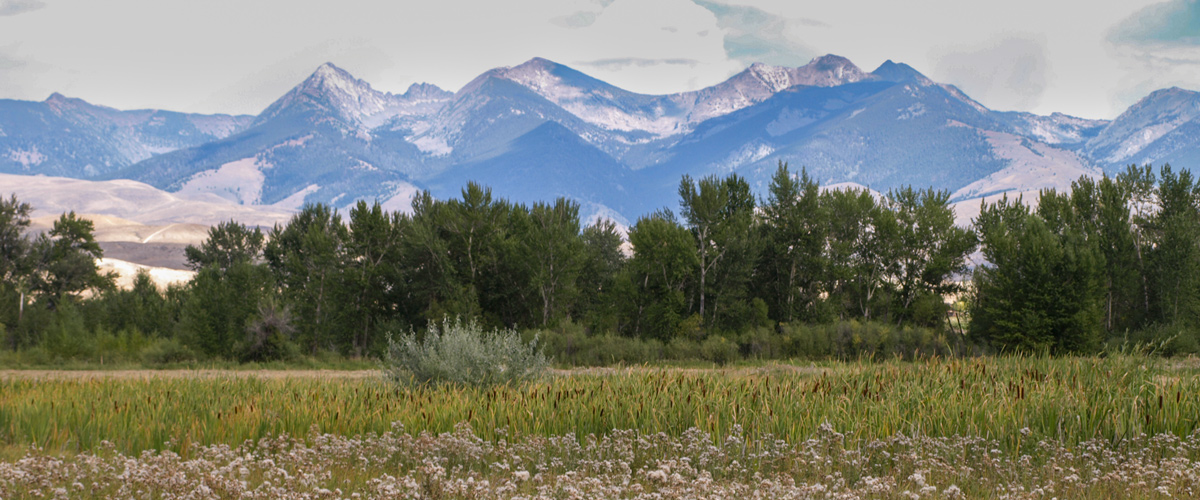At a Shoshone village on the Lemhi River, Lewis asks Cameahwait to help bring the expedition’s baggage over the Continental Divide. George Drouillard interprets between the two using Plains Sign Language.
Passing the Rattlesnake Cliffs, the men ache from having to haul the heavy dugouts over rocks in the cold and shallow Beaverhead River. Clark reprimands Toussaint Charbonneau for striking Sacagawea.
Lewis Seeks Help
Lemhi River Valley
View northeast
© 9 September 2008 by Kristopher K. Townsend. Permission to use granted under the Creative Commons Attribution-Share Alike 4.0 International license.
Obtaining Information
In order to give Capt. Clark time to reach the forks of Jefferson’s river I concluded to spend this day at the [Lemhi] Shoshone Camp and obtain what information I could with rispect to the country.
—Meriwether Lewis
Universal Sign Language
The means I had of communicating with these people was by way of Drewyer who understood perfectly the common language of jesticulation or signs [Plains Sign Language] which seems to be universally understood by all the Nations we have yet seen. it is true that this language is imperfect and liable to error but is much less so than would be expected. the strong parts of the ideas are seldom mistaken.
—Meriwether Lewis
Request for Shoshone Help
I now told Cameahwait that I wished him to speak to his people and engage them to go with me tomorrow to the forks of Jeffersons river . . . . that I wish them to take with them about 30 spare horses to transport our baggage to this place where we would then remain sometime among them and trade with them for horses, and finally concert our future plans for geting on to the ocean and of the traid which would be extended to them after our return to our homes. he complyed with my request and made a lengthey harrangue to his village.
—Meriwether Lewis
Spanish Horses and Goods
Drewyer who had had a good view of their horses estimated them at 400. most of them are fine horses. indeed many of them would make a figure on the South side of James River or the land of fine horses.— I saw several with spanish brands on them, and some mules which they informed me that they had also obtained from the Spaniards. I also saw a bridle bit of spanish manufactary, and sundry other articles which I have no doubt were obtained from the same source.
—Meriwether Lewis
Clark Passes the Rattlesnake Cliffs
Rattlesnake Cliffs
© 21 July 2013 by Kristopher K. Townsend. Permission to use granted under the Creative Commons Attribution-Share Alike 4.0 International license.
For a comparison between the above beaver-shaped rock and the other similarly shaped rock that Sacagawea pointed to, see The Rattlesnake Cliffs.
Cold, Achy, and Injured
we took an eairly breakfast and Set out. the [water?] is verry cold. We have to waid in it which makes our feet and legs ake with cold. we expect it is made of Springs
—John Ordway
Clark Lends a Hand
The hunters Jo. [Joseph Field] & R. Fields [Reubin Field] killed 4 Deer & a antilope [pronghorn], I killed a fat Buck in the evening, Several men have hurt themselves pushing up the Canoes. I am oblige to a pole occasionally.
—William Clark
Charbonneau Strikes Sacagawea
the river near the mountain is one continued rapid, which requres great labour to push & haul the Canoes up. We Encamped on the Lard Side near the place the river passes thro’ the mountain. I checked our interpreter [Toussaint Charbonneau] for Strikeing his woman [Sacagawea] at their Dinner.
—William Clark
Weather Diary
State of the Thermometer at rise
Weather at rise
Wind at rise
State of the Thermometer at 4 P.M. Weather at 4 P.M. Wind at 4 P.M. 51 [above 0] fair after rain N W. 76 [above 0] fair N W met with the Snake Indians, visit their camp
—Meriwether Lewis[1]To assist the reader, the editor of this web page has omitted the date column and spelled out some abbreviations.
Notes
| ↑1 | To assist the reader, the editor of this web page has omitted the date column and spelled out some abbreviations. |
|---|
Experience the Lewis and Clark Trail
The Lewis and Clark Trail Experience—our sister site at lewisandclark.travel—connects the world to people and places on the Lewis and Clark Trail.
Discover More
- The Lewis and Clark Expedition: Day by Day by Gary E. Moulton (University of Nebraska Press, 2018). The story in prose, 14 May 1804–23 September 1806.
- The Lewis and Clark Journals: An American Epic of Discovery (abridged) by Gary E. Moulton (University of Nebraska Press, 2003). Selected journal excerpts, 14 May 1804–23 September 1806.
- The Lewis and Clark Journals. by Gary E. Moulton (University of Nebraska Press, 1983–2001). The complete story in 13 volumes.



